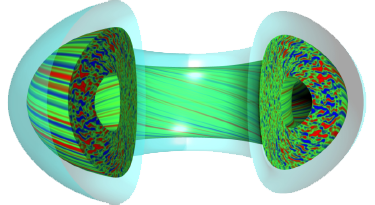Speaker
Description
Integrated Data Analysis (IDA) allows to infer plasma quantities like electron density using heterogeneous data sources. Essential is forward modelling with physically reasonable models to the data space for probabilistic evaluation. The paper presents the progress in extending the set of AUG's diagnostics for electron density profile inference by a microwave reflectometry system.
For swept density reflectometry a FM-CW signal is directed radially into the plasma where it interacts and is eventually reflected when the plasma density exceeds the frequency-dependent cut-off frequency of the probing wave. The returning wave is mixed with a reference wave and the beating signal is observed using a square law detector. The determination of density profiles from the beating signal is an ill-posed inverse problem, classically solved by an Abel inversion.
An efficient semi-analytical forward model is presented, which allows IDA to overcome problems associated with the classic determination of cut-off locations via Abel inversion. Instead of using a hard coded initialisation for densities below the first measured cut-off density, other diagnostics like the lithium beam are used to inform the shape of this part of the profile.
Error propagation of uncertainties in the density profile is inbuilt in the Bayesian approach. This is essential, as each evaluated chirp frequency and the associated group delay (derivative of the collected frequency wrt chirp frequency) is an integrated measure of the entire density profile up to the reflection point. This allows reliable estimation of the uncertainty in the gradient, which is an important input for modelling codes.
Also, by using forward modelling the frequencies measured twice, due to overlapping bands, can be fully included. At the same time a gap in the group delay - e.g. due to poor SNR or a missing band - does not prevent inferring the profile at higher cut-off densities. Missing data simply increases the uncertainty for densities beyond the gap. In addition the inferred density model is unequivocal, so that no ambiguities in the density profile can arise. Abel inversion provides the cut-off position as function of cut-off density, which is not necessarily monotonic.
As IDA uses various diagnostics to infer the density profile, systematic disagreements between them are revealed and can be studied to improve the understanding of the diagnostics and their modelling. A set of plasma conditions is presented, for which agreement and also disagreement between reflectometry and other diagnostics is observed. The differences are discussed and set into context of the remaining limitations of the currently used forward model.
| Country or International Organisation | Germany |
|---|---|
| Affiliation | Max Planck Institute for Plasma Physics |

